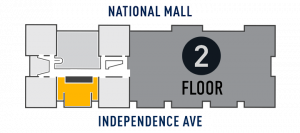This is a film transport assembly flown to the Moon on Apollo 16 that was returned to Earth for the extraction and processing of the exposed film. It was acquired by the Museum in the process of reconstructing the back-up engineering model of the first astronomical telescope to observe from another planetary body. The original unit was designed and built by George Carruthers of the Naval Research Laboratory, who also supported the reconstruction and reintegration. On the moon, the film transport mechanism was operated by astronaut John Young in a programmed series of studies of the Earth's outermost atmosphere, its geocorona. It was also used to examine ultraviolet colors of stars and nebulae as well as the earth's upper atmosphere and diffuse gaseous material in the depths of space. The camera operated in dual mode: spectroscopic and direct view.
This artifact has been installed in one of two back-up units to the flown camera that were transferred from NASA-Johnson Space Center to the Museum in June 1981.
Display Status
This object is on display in Destination Moon at the National Air and Space Museum in Washington, DC.

Object Details
Country of Origin
United States of America
Type
INSTRUMENTS-Scientific
Manufacturer
Naval Research Laboratory
Dimensions
3-D (Film Cassette): 21 × 15.2 × 10.2cm (8 1/4 × 6 × 4 in.)
3-D (pin): 6.4 × 2.5 × 1.3cm (2 1/2 × 1 × 1/2 in.)
Materials
Film Cassette: Steel, aluminum, gold plating, electrical wires, plastic
Pin: Steel
Inventory Number
A20160069000
Credit Line
Transferred from the Naval Research Laboratory
Data Source
National Air and Space Museum
Restrictions & Rights
Usage conditions apply
For more information, visit the Smithsonian’s Terms of Use.